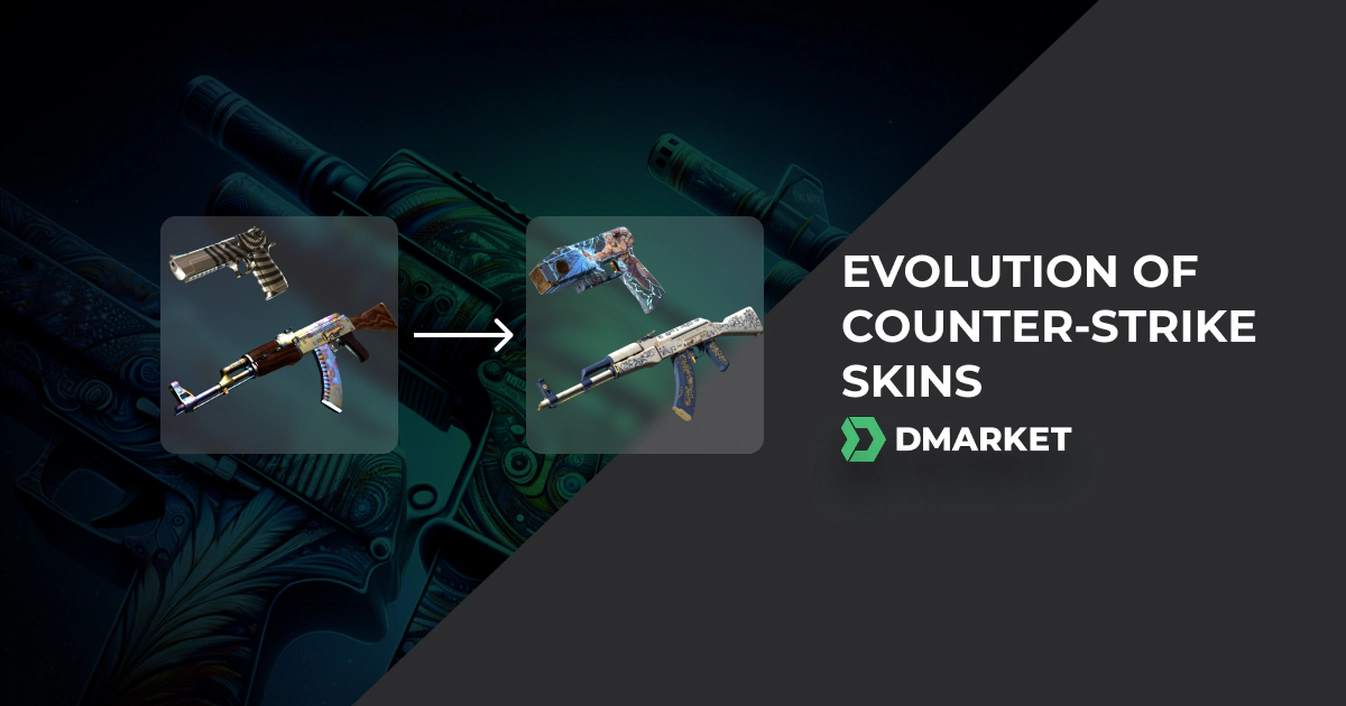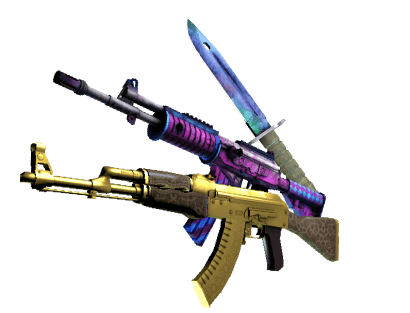Evolution of Counter-Strike Skins (From CS 1.6 to Counter-Strike 2)
Can you believe there was a time when Counter-Strike had no weapon skins? A dark era indeed!
Now, with CS2 to enjoy and compete in, skins are such an integral part of the experience. And even more, they have pushed the title to become one of the most popular games and an elite esports discipline. With such a role, skins certainly deserve to be studied—but sure, in a relaxed, entertaining way.
While you are already on DMarket, a place where you can buy CS2 skins at the best price, you should probably know what these items actually are. Yep, they are images that cover game weapons, changing their appearance but having no effect on gameplay.
Still, skins in Counter-Strike are a game-changing element, without a doubt. If you have something like The Empress on your AK-47 or Desert Hydra on your AWP, the whole atmosphere in matches changes. You will be confident and effective in offense, and your bullets get a boost in accuracy—thanks to your heightened focus and interest.
With the basics covered, let’s dive into the history of CS skins and highlight their impact on the game, its community, and even gaming culture in general. It’s a journey from a fun image to an item with significant economic value.
Early Days of Skins (Pre-CS:GO)
The birth of skins in Counter-Strike reflects the role of community in this game. Players are the main moving power here. They (we) take everything CS has to offer and make it alive with our presence and activities—otherwise, the game is just an empty virtual space. And in addition to this, players fill Counter-Strike with creative pieces and brilliant ideas. The community adds lots of awesome mods and maps to the Steam Workshop; some of them get promoted to become official content. It’s basically how skins were created.
There were no official custom images for your Counter-Strike weapons before CS:GO and specifically the Arms Deal update. But you certainly could use various community-driven additions to the main game, skin mods.
Such an opportunity to make your weapons prettier was available even back in the Counter-Strike 1.6 era. Those were simpler times. All you needed to do was to go to a specialized website, scroll through many (so many!) skin mods, and then download them to use in the game. Yes, totally for free.
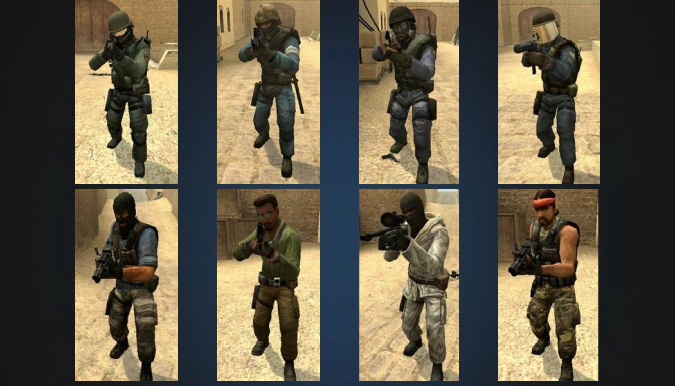
The community shined with creativity back then; everything was possible. You could open a graphics editor and bring your wildest dream to life, share it with friends, give it to people on the internet, and have no limitations on seeing your skin in action.
This idea was so cool, people liked it a lot, and Valve could not ignore how popular the images were. With the release of CS:GO, the developers decided to take skins under their control. First, community creations were transferred to a special Workshop section in the game. And then, official skins were introduced to Counter-Strike: Global Offensive as part of the Arms Deal update (absolutely legendary at this point). A new industry was formed.
We still have community-created items in CS2, but people want the official skins to show off in multiplayer.
The Introduction of Skins in CS:GO
Around a year after the release of CS:GO, Valve unleashed this historic update. The Arms Deal introduced skins, which changed the game and the community forever.
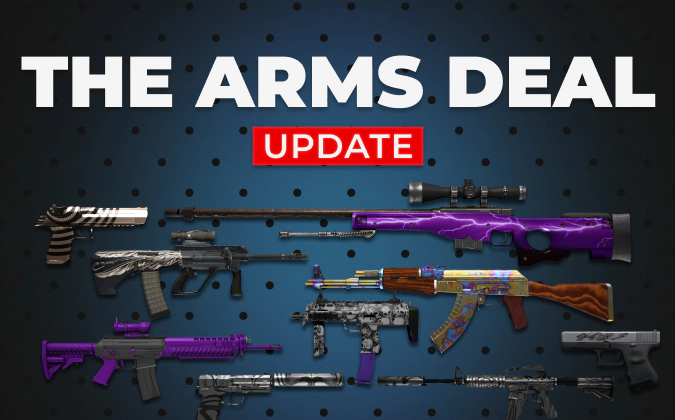
In August 2013, Counter-Strike got its first 100 skins, divided into ten Collections: Assault, Office, Nuke, Militia, Inferno, Vertigo, Aztec, Dust, eSports 2013, and Arms Deal.
The tradition of obtaining skins from drops directly in the game started back then too. But also, we got the first-ever CS:GO weapon cases—the exciting chance to obtain super rare skins that could (hopefully) cost more than the key necessary to open the case. Players can get cases from the drops too, and that happens quite often.
Let’s name the two cases added to the game with the Arms Deal. You can get skins for CS2 from them, and these items are quite rare.
- CS:GO Weapon Case—it’s one of the most expensive Counter-Strike cases now; many people pay for it to have the chance of obtaining AK-47 | Case Hardened, one of the most valuable skins.
- eSports Weapon Case—this one is remarkable as it was created to support the competitive community. A portion of revenue from selling the case was directed to funding official esports events.
Skins give players extra motivation to spend time in the game, battling for high placements in CS2 rank distribution, and even invest money in the future development of Counter-Strike. Huge prize pools of modern CS2 esports have become possible strictly thanks to skins.
Development of the Skin Market
A huge part of this update was the option to trade skins through the Steam Marketplace. The community was so hyped about rare and cool-looking skins, and the hunt for them started. Valve developed a quality system for Counter-Strike skins in Collections and cases. It remains even now, strongly affecting how the skin market operates.
There are a few levels of rarity for skins, easily recognizable by the colors: from White (Consumer Grade) to Gold (Rare Special). We discuss the system in this dedicated article, so check it out for details.
Practically, this division on rarity has become a basis for skins’ value:
- Rare skins (Classified, Covert, Contraband) are naturally available in limited numbers, as they drop… well, rarely. People dream about them. People are ready to pay thousands of dollars for them.
- Skins of lower rarity drop quite often (Restricted, Mil-Spec, Industrial Grade, Consumer Grade), and players don’t use all of them. They want to sell some items and get something else.
Perhaps a bunch of lower-grade skins will be enough to buy that rare and awesome gun?
Rarity effectively supports the hype around skins, making people super eager to play the game and pay money for specific items or risk opening a case.
As the Steam Marketplace has no payout options, the community needed an alternative. Third-party trading platforms appeared, and some people became professional traders, making revenue from buying skins cheaper and then selling them for a higher price.

Sure, features of third-party platforms are not limited to just buy-sell transactions. You can also exchange skins through trading bots. But the general point is that skins got real-world value. While some look for great weapons to show off during their playing sessions, others predict which skins will be more expensive and invest a lot of cash in them.
Major Updates and Impactful Changes
After the Arms Deal update, Valve made a few other powerful moves. The first CS:GO Operation, Payback, started in August 2013. While it did not contain new skins, it formed another new tradition: regular in-game events. Operation Bravo started in September, and it was a huge success. Valve decided to prolong it and give more people a chance to get skins from the new Alpha Collection, and the new Operation Bravo case.
Since then, new cases and Collections are often related to specific Counter-Strike Operations, and when these events are over, skins/cases from them become especially rare, as they do not drop from the game anymore. (Such items are often considered a good investment.)
A lot (really a lot) of new Counter-Strike Collections and cases were released in 2013 and 2014. For this relatively short period, Valve created a super strong variety of skins to support the market—and basically, give people what they asked for.
The amount of active players increased significantly thanks to this. While there were 42,149 peak players in July 2013, the number increased to 819,902 in August 2015 (according to steamcharts), when Operation Bloodhound was active.
Let’s not list all the Collections here. They can easily be seen on the CS2 skins marketplace DMarket thanks to the special filter. It would be more interesting to highlight how skins created a new industry.
Many important features have expanded the basic rarity formula. Some of them were added right to the first 100 skins of the Arms Deal. Others were introduced by Valve in subsequent updates.

- StatTrak generally increases the rarity and price of CS2 skins. The kill counter on specific weapon skins was introduced with the Arms Deal, and became a super important aspect of a skin’s value.
- Float Values are not as straightforward as they may seem. Yes, most often, the freshest skins of the Factory New exterior look better and cost more. But if Valve decides to release a smaller number of, say, Well-Worn skins, they will be more expensive. Sometimes worn skins look better, but it is rare. Some consider the AWP | Asiimov being of that sort. Skins such as Desert Eagle | Blue Ply look different with a higher float—wooden textures appear on the pistol.
- Patterns matter a lot for some skins, such as Case Hardened. The exact colors are formed randomly, and sometimes we get unique images. For example, when Case Hardened weapons have a lot of blue, they become rare and super expensive. People even call them Blue Gems. With rare blue stickers (like Titan (Holo) | Katowice 2014) we can get absolutely mind-blowing combinations. In 2021, someone offered €1.2M for a Factory New Karambit | Case Hardened with the rarest pattern 387, and the owner refused, saying that was too little.
- Phases change the appearance of Doppler skins and affect their price. In a way, it’s a form of pattern but with a better division between phases and clear classifications of them for different skins. For example, there are four numeral phases for Doppler knives and three color ones: Ruby, Sapphire, and Black Pearl. Thus we have lots of skin variations and more options for players to express their personality through cosmetic items.
- Stickers were released to CS:GO in February 2014, and first they weren’t too popular. Later, the situation changed, and having a cool sticker on a cool skin began to boost price and rarity. Those first stickers from the Katowice 2014 capsule are such a treasure nowadays. With the possibility to place five stickers on a skin wherever you want, familiar skins can be highly personalized. Such a feature was introduced in CS2 as part of the update A Call to Arms.
- Souvenir skins are tightly connected to major esports tournaments. They can be obtained exclusively from Souvenir Packages. Initially, these special cases could drop to stream viewers, but after StarLadder Berlin 2019, players needed to buy Souvenir tokens first and then spend them on Souvenir Packages. The skins themselves may look identical to non-Souvenir ones, and only their name and some attributes will be different (yellow frame and text).
Throughout the whole evolution of Counter-Strike skins, Valve is the ultimate power behind… literally everything. The company can change the drop rate, making skins rarer or more common. Stability with these factors is crucial, though, and the developers do that only when it’s super necessary.
A prominent example in this regard is M4A4 | Howl, the only Contraband skin in Counter-Strike. It was added to the community Workshop and then promoted to the official one. But later, it turned out that the “creators” took someone else’s artwork without permission. Valve changed the image slightly to not violate copyright and removed the skin from the Hunter case. It’s not possible to obtain Howl even through trade-up contracts.
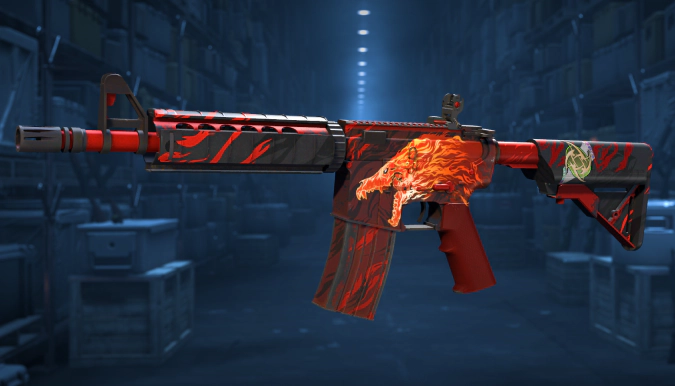
When such copyright issues arose again, Valve followed a different path. They changed the image without adjusting drop rates.
Mistakes can happen during skin creation. Once, they released a vanilla Karambit knife with a 0 float and no star in the name. It’s the only such item in existence.
Counter-Strike skins have created a unique phenomenon that certainly affects general gaming culture.
Don’t forget that awesome skins in your inventory should be a reflection of your real skills. Do not embarrass yourself while taking great weapons to a match. Become a better player thanks to our CS2 tips and tricks.
Cultural Impact
The success of Counter-Strike skins has inspired other games to add customizable weapons. Some of them joined the market of tradable items (such as Rust, which is also present on DMarket).
The general scale of skins trading attracted lots of people and powered up many projects. For example, Counter-Strike skins could be a kind of currency on various gambling platforms. 2015 was the dawn of this “industry”. People could bet skins hoping to win better skins. But the casino always wins. Revenues of such doubtful projects went over the moon, and they sponsored many popular YouTubers to bring even more people to this type of gambling. Some of those influencers opened their own betting platforms and then promoted them.
Eventually, Valve decided to interfere. They directly banned a few projects from using skins. They added a 7-day trade ban to create extra obstacles for general betting with skins. These actions were relatively successful, and those platforms cannot operate as freely as before.
But Valve itself had problems with gambling. In 2019, three countries banned the opening of Counter-Strike cases: the Netherlands, Belgium, and France. That means the skins became big enough to attract the attention of governments and make countries release special laws to regulate cosmetic items.
Valve had to find ways to still operate in countries with strict limitations. When Counter-Strike was officially released in China, the developer had to reveal drop chances for every skin rarity. The world was affected by CS items, and CS items were affected by the world.
This mutual impact was nicely felt during the pandemic. People were stuck at home, and many of them dedicated their time to playing video games, including Counter-Strike. In April 2020, CS:GO had its remarkable peak of concurrent players, 1,305,714. It was beaten only in 2023 thanks to the hype around CS2. Naturally, skins became more popular and their prices increased.
With esports tournaments being canceled for that period, professional esports organizations were in trouble, and Valve once again supported them by releasing a special sticker capsule, 2020 Regional Major Rankings. Actually, it’s mutual support, as skins can be seen all over the professional CS2 events.
Some players keep their old items as proof of their exceptional experience. Others prefer freshly released weapons. But all of them promote skins, while having the whole esports dimension funded mainly by skin sales. Sometimes pro players are temporarily loaned super rare skins from their owners to showcase them at the biggest esports events.
Another integral part of modern gaming is streaming, and it’s not a rare situation when popular influencers show how they open cases instead of actually playing CS2. Moments when people get a knife or gloves are filled with such mighty emotions that they become viral clips.
Forming the trading community is also a cultural impact, don’t you think? People look for rare skins and interact with each other on various platforms. Alas, this created some negative sides, such as fraud. We at DMarket don’t get tired of reminding people about the importance of maintaining security and specifically the importance of 2FA in skins trading. Please, make sure you’ve checked out our advice to experience only the bright side of Counter-Strike skins.
The Art and Design of Skins
Remember that part about the role of community in skins and Counter-Strike in general? It certainly remains true even in the modern era of officially supported cosmetic items. Many of them are created by people from the community, and such skins are truly amazing pieces of art.
Take your time to scroll through the first Collections and cases. Then take a look at much later skins. It’s easy to notice progress in artistic bravery and colorful extravaganza.
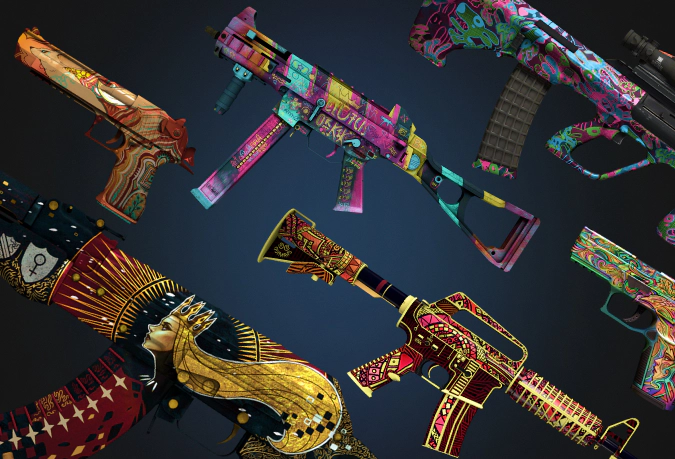
To create this beauty, Valve collaborates with various artists. The path is generally identical (and you can try and follow it). People create skins using 2D and 3D graphic edition apps, like Photopea and Blender. They upload skins to the Workshop, promote them through their social accounts, and hope for Valve officials to notice their work. Getting art pieces added to an official Collection of CS2 skins is quite a profitable success!
Valve pays generously for new skins ideas and organizes community design contests with impressive prize pools. There was a Workshop contest for the Dreams & Nightmares case with a total prize pool of $1M. Each winner got $100,000.
Unusual creative solutions may help artworks make it to the official Collections. Take a look at SSG 08 | Parallax and M4A1-S | Leaded Glass; they have impressive 3D effects and stand out of the crowd thanks to that.
Still, don’t fall under any illusion here. Creating skins is hard artistic work with a lot of uncertainty. You should approach it with thoughts like “Oh, I have an idea about this skin” or “I really want to have this skin in Counter-Strike” instead of “Let’s draw something and earn a lot of money.”
Just head to the workshop to see all the amazing skins there or check all the best CS2 workshop skins in our article. Sure, you may be one of the artists, don’t get discouraged.
It’s a good idea to explore art of successful creators, such as
- de puiseau, the creator of MAC-10 | Pipe Down and SG 553 | Heavy Metal
- Mals1, a pro player and the creator of Galil AR | Black Sand and Glock-18 | Moonrise
- Coridium, the creator of the iconic Asiimov skins family.
Future of Skins
One recent step from Valve was super important for the whole Counter-Strike community, and specifically for the skins trading industry. The company released their newest game, CS2, and all skins from Global Offensive continued their presence in this installment.
It was a clear message about the bright future of Counter-Strike skins. These items are here to stay, and they are worth investing in.
We got the update A Call to Arms recently, with the first-ever CS2 weapon case, Kilowatt, and a few fresh skins—players may even want to get rid of HUD to see items in their full glory, with no distractions.
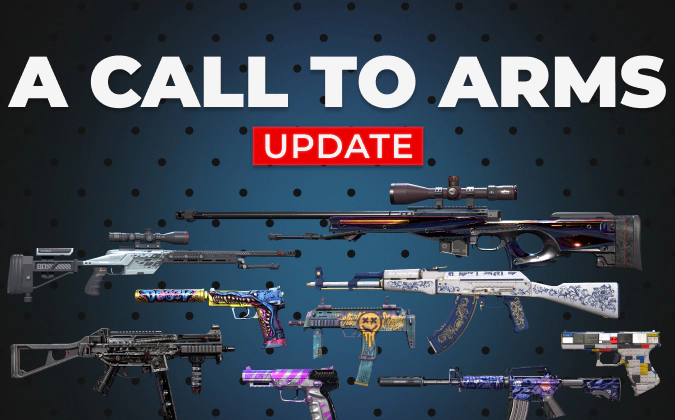
The next step should be the start of the first-ever Operation in Counter-Strike 2, with addition of new CS2 skin Collections.
Maybe we will get some stories like with AK-47 | Howl. Maybe new legends will be born, like the most expensive ever AWP | Dragon Lore Souvenir skin. It’s a journey with many unknowns, but it sure is exciting.
And again, having stability of the skins environment confirmed by Valve is super important for both gamers and traders.
The evolution of Counter-Strike skins continues, and in a way, it will be a reflection of the general development of human culture. Will we get even more cheerful colors? Will we get aggressive war patterns on weapons? Let’s wait and see what artists will create and what Valve will approve. We at DMarket are super excited to witness what happens next.
One thing is pretty certain about Counter-Strike skins. They are created by the community, they transform thanks to the players, and their current role as art pieces and real-world value depends on people. It’s nice to see our collective power making a difference in the world!
Counter-Strike in general keeps a great balance of being honest to its roots and following modern progressive trends. With skins, the game moved to the area of significant values and mighty economic impact. Is anyone still surprised that a CS2 skin can cost more than a luxury sports car?
Trade on the go - install the mobile app of DMarket from Google Play or App Store. Never miss great prices and unique skins. The best CS2, Dota 2, Rust and TF2 marketplace is always at hand!


Stay tuned to DMarket Blog and follow us on Facebook and Twitter for more interesting and helpful info on CS2 skins and the game items trading industry.











